Tuesday, March 12th 2013

AMD Announces Next-Generation "Richland" A-Series Mobile APUs
AMD today announced the first availability of the AMD Elite A-Series Accelerated Processing Units (APUs), codenamed "Richland." The new AMD Elite A-Series APUs deliver innovative user experiences like facial log-in and gesture recognition, improved graphics1 and compute performance over the previous generation, and enhanced power management capabilities on a single chip.
"The high performance AMD A-Series APU continues to impress with its ability to deliver stunning graphics and immersive experiences with even more battery life. Our engineers have done a superb job of increasing processor performance while decreasing power consumption," said Bernd Lienhard, corporate vice president and general manager of AMD's Client Business Unit. "With the capabilities built into our 2013 AMD Elite A-Series APUs, including new software for gesture control, facial recognition, rich entertainment and more lifelike gaming, we are delivering an ever richer experience to end users and our customers."With faster performance and improved power management in the same platform architecture as its predecessor, coupled with AMD Radeon HD 8000 Series graphics, the 2013 AMD Elite A-Series APUs build on the award-winning history of AMD's original APU line-up to help users get the most out of their notebooks, whether at work, at home or on-the-go.Differentiated User Experiences
The new AMD Elite A-Series APUs leverage the power of the combined compute and graphics cores to accelerate a suite of available software experiences that can dramatically expand and enhance the user experience:
Next Level Performance
Through engineering optimizations on the previous generation of the AMD A-Series APU platform architecture (formerly codenamed "Trinity") and updated graphics, the 2013 AMD Elite A-Series APUs feature significant performance increases, along with support for high-end technologies:
AMD continues a power/performance leadership through the latest generation of power management technologies. These boosting and throttling technologies enable more intelligent, higher compute and graphics core performance to help enhance PC responsiveness and extend battery life. Building on the idea of AMD AllDay Power, the 2013 AMD Elite A-Series Platform enables up to 7.9 hours of web browsing, 5.7 hours of HD video playback and up to 10 hours of resting battery life on a 55 watt/hour battery.
Availability and Technical Details
Performance and traditional notebooks based on these 2013 AMD Elite A-Series APUs are shipping now with availability beginning this month in select regions. Model numbers and technical details for each are as follows:
"The high performance AMD A-Series APU continues to impress with its ability to deliver stunning graphics and immersive experiences with even more battery life. Our engineers have done a superb job of increasing processor performance while decreasing power consumption," said Bernd Lienhard, corporate vice president and general manager of AMD's Client Business Unit. "With the capabilities built into our 2013 AMD Elite A-Series APUs, including new software for gesture control, facial recognition, rich entertainment and more lifelike gaming, we are delivering an ever richer experience to end users and our customers."With faster performance and improved power management in the same platform architecture as its predecessor, coupled with AMD Radeon HD 8000 Series graphics, the 2013 AMD Elite A-Series APUs build on the award-winning history of AMD's original APU line-up to help users get the most out of their notebooks, whether at work, at home or on-the-go.Differentiated User Experiences
The new AMD Elite A-Series APUs leverage the power of the combined compute and graphics cores to accelerate a suite of available software experiences that can dramatically expand and enhance the user experience:
- AMD Face Login - Uses facial recognition technology and a webcam to allow for quick log-in to Windows and other browser-based websites that require a log-in, like social networking sites and email services;
- AMD Gesture Control - Tracks a user's hand gestures and converts them into commands for basic functions on media players, browsers, e-readers and other popular applications leveraging a webcam, advanced image processing and machine-vision algorithms;
- AMD Screen Mirror - Wirelessly shares content like photos, videos, HD media streams and webpages from a PC or tablet based on a 2013 AMD A-Series APU with any supported TV or display with a DLNA receiver, or with other PCs. Available only on select AMD-based devices;
- AMD Video Entertainment Features - Make your content look its very best: AMD Steady Video technology gives users push-button control over shaky home video and helps stabilize the images for better viewing; AMD Quick Stream technology7 enables smooth video streaming and a virtually interruption free streaming experience; and AMD Perfect Picture HD8, creates rich and lifelike color on video entertainment.
Next Level Performance
Through engineering optimizations on the previous generation of the AMD A-Series APU platform architecture (formerly codenamed "Trinity") and updated graphics, the 2013 AMD Elite A-Series APUs feature significant performance increases, along with support for high-end technologies:
- Visual and compute performance increases over the previous generation of AMD A-Series APUs;
- AMD Start Now Technology for tablet-like responsiveness;
Improved AMD Turbo CORE technology with higher boost frequencies than the previous generation, for more performance when you need it and energy conservation when you don't; - Support for AMD Eyefinity technology10, AMD Radeon Dual Graphics, and DirectX 11.
AMD continues a power/performance leadership through the latest generation of power management technologies. These boosting and throttling technologies enable more intelligent, higher compute and graphics core performance to help enhance PC responsiveness and extend battery life. Building on the idea of AMD AllDay Power, the 2013 AMD Elite A-Series Platform enables up to 7.9 hours of web browsing, 5.7 hours of HD video playback and up to 10 hours of resting battery life on a 55 watt/hour battery.
Availability and Technical Details
Performance and traditional notebooks based on these 2013 AMD Elite A-Series APUs are shipping now with availability beginning this month in select regions. Model numbers and technical details for each are as follows:
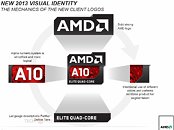


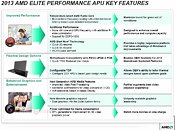
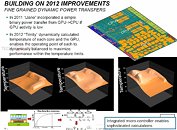
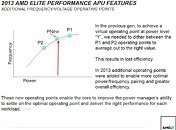
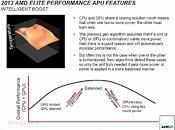
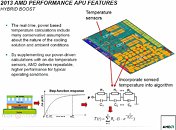
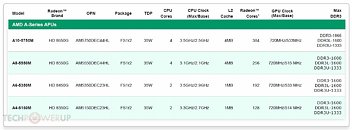
35 Comments on AMD Announces Next-Generation "Richland" A-Series Mobile APUs
"An accelerated processing unit (APU) is a processing system that includes additional processing capability designed to accelerate one or more types of computations outside of a CPU. This may include a graphics processing unit (GPU) used for general-purpose computing (GPGPU), a field-programmable gate array (FPGA), or similar specialized processing system"
I think AMD is trying to push the term APU so that people can tell the difference between the two.. Even though Intel can use the term APU, I don't think they would go far into using it since whenever most think of a CPU, they think intel. So, my thought is APU will be branded into the term for AMD...
Wonder how switchable graphics will work with them. I know intel/amd it was a pain to try to get working.
But Intel market the it as CPU because enthusiasts associate APUs with being low performance mobile parts, thus causing confusion as the 2600K is a high end part.
But Ivy / Sandy Bridge on the other hand is an APU, Intel can get away with calling it just a CPU. Customers can't sue because Intel will argue they are getting a free integrated element.
With Intel it's all marketing, as I said APUs are associated with low end parts. If Intel called Ivy Bridge an APU noobs will think it's a low end part like the AMD Llano or AMD Trinity. Which it's not.
Desktop version will come in 95W TDP is my guess and the top will be an A10-5900K.
APUs offer better performance and lower heat and cost over comparable discrete CPU/APU packages. Eventually we will all be using APUs as they are the logical evolution of the discrete components.
Richland == Trinity.Overclock()
Maybe next time they can call it EPU like ASUS does, but then make it Extreme Processing Unit lol or MPU maximum processing Unit, or SPU, Supreme Processing Unit, or here is a good one, IPU, integrated processing unit.
CPU still is what makes sense for most, as the GPU has become much more integral in system processing.
EDIT: Just noticed that only the A10 has DDR3-1866 support - why not extend it to the other SKU's ?
Also, a salient point for those people lambasting me for suggesting that Richland wasn't GCN:[source #1] [source #2]
The weakness of APUs is the reliance on RAM speeds due to the shared VRAM. If you notice on the consoles, the PS4 has extremely fast RAM coupled with it's APU. If we had the same on desktop then there would be no point for AMD to make FX and APUs. Just put the graphics on an FX chip and run with it cause the RAM speed would not be a bottleneck anymore.